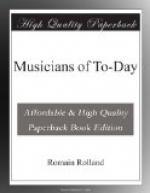But I must stop. I have said enough to show the fun the author is indulging in. When one hears the work one cannot help admiring the composer’s technical knowledge, skill in orchestration, and sense of humour. And one is all the more surprised that he confines himself to the illustration of texts[178] when he is so capable of creating comic and dramatic matter without it. Although Don Quixote is a marvel of skill and a very wonderful work, in which Strauss has developed a suppler and richer style, it marks, to my mind, a progress in his technique and a backward step in his mind, for he seems to have adopted the decadent conceptions of an art suited to playthings and trinkets to please a frivolous and affected society.
[Footnote 177: Arthur Hahn, Der Musikfuehrer: Don Quixote, Frankfort.]
[Footnote 178: At the head of each variation Strauss has marked on the score the chapter of “Don Quixote” that he is interpreting.]
In Heldenleben ("The Life of a Hero"), op. 40,[179] he recovers himself, and with a stroke of his wings reaches the summits. Here there is no foreign text for the music to study or illustrate or transcribe. Instead, there is lofty passion and an heroic will gradually developing itself and breaking down all obstacles. Without doubt Strauss had a programme in his mind, but he said to me himself: “You have no need to read it. It is enough to know that the hero is there fighting against his enemies.” I do not know how far that is true, or if parts of the symphony would not be rather obscure to anyone who followed it without the text; but this speech seems to prove that he has understood the dangers of the literary symphony, and that he is striving for pure music.
[Footnote 179: Finished in December, 1898. Performed for the first time at Frankfort-On-Main on 3 March, 1899. Published by Leuckart, Leipzig.]
Heldenleben is divided into six chapters: The Hero, The Hero’s Adversaries, The Hero’s Companion, The Field of Battle, The Peaceful Labours of the Hero, The Hero’s Retirement from the World, and the Achievement of His Ideal. It is an extraordinary work, drunken with heroism, colossal, half barbaric, trivial, and sublime. An Homeric hero struggles among the sneers of a stupid crowd, a herd of brawling and hobbling ninnies. A violin solo, in a sort of concerto, describes the seductions, the coquetry, and the degraded wickedness of woman. Then strident trumpet-blasts sound the attack; and it is beyond me to give an idea of the terrible charge of cavalry that follows, which makes the earth tremble and our hearts leap; nor can I describe how an iron determination leads to the storming of towns, and all the tumultuous din and uproar of battle—the most splendid battle that has ever been painted in music. At its first performance in Germany I saw people tremble as they listened to it, and some rose up suddenly and made violent gestures quite unconsciously. I myself had a strange feeling of giddiness, as if an ocean had been upheaved, and I thought that for the first time for thirty years Germany had found a poet of Victory.




